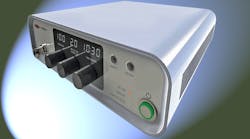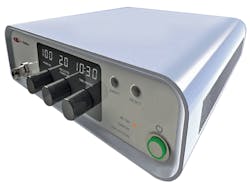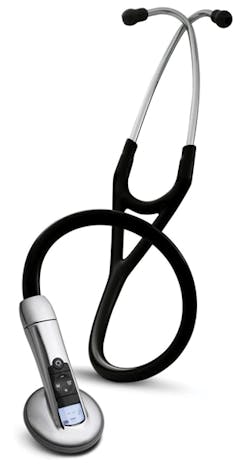This file type includes high-resolution graphics and schematics when applicable.
Microwave technology has long been a powerful partner to medical professionals for the treatment of different types of cancerous and noncancerous tumors. The application of electromagnetic radiation (EM) at typically unlicensed frequencies (such as 915 and 2450 MHz) provides a minimally invasive method of shrinking tumors by means of localized dielectric heating of the water content of tissue masses.
This technique, known as microwave ablation, has served many different medical areas, including cardiology, gynecology, rhizotomy, and even in some dental treatments. It represents a realistic treatment option for patients considered high surgical risks.
Microwave ablation is a mature technology, and just one of the ways in which RF/microwave energy currently contributes to improved health. The technology has cleared countless lung, liver, and prostate tumors, and spurred the growth of an equipment industry for high-power medical ablation sources, such as the model MSYS245 microwave generator from Emblation Microwave.
The compact source (Fig. 1) is capable of 100 W output power with pulse-width modulation (PWM) at 2.45 GHz. It represents a departure from earlier, larger magnetron-based microwave ablation sources, using solid-state amplification. The source employs gallium-nitride-on-silicon-carbide (GaN-on-SiC) transistors to provide the generous output power needed for dielectric tissue heating.
Medical ablation is also performed at lower frequencies, known as RF ablation, and at higher frequencies from 5.8 to 10.0 GHz. Use of lower-frequency electromagnetic (EM) energy for heating of bone and tissue relies on a conductive path, with access to the area to be treated. In contrast to microwave ablation, which employs an antenna to direct higher-frequency signals around an area of interest, RF ablation will channel lower-frequency energy to a relatively small volume of bone or tissue for heating. With higher-frequency microwave ablation, application of heating EM energy with minimal penetration of a target is possible, making it quite an effective tool, for example, for skin-based ablation treatments.
Traveling with Telemedicine
Wireless technology has played a growingly important role in modern medicine—the combination of which is known by the general term “telemedicine.” Prior to current invasive and noninvasive medical applications for monitoring organs and health conditions, the medical exploits of low-power wireless signals came in the form of radio-frequency-identification (RFID) technology to help label both medicines and patients.
The cost of RFID integrated circuits (ICs) has dropped dramatically during the past decade, allowing their use throughout the healthcare industry at a number of different frequencies. Frequency depends on location—HF tags are typically used at about 27 MHz with only microwatts of power, for a read distance of only about 3 in., and UHF tags work with milliwatts of power from 902 to 928 MHz in North America for longer read distances. Companies such as Vizinex RFID, specializing in custom medical RFID products, offer design capabilities to add RFID to different medical products and equipment, including for tracking the whereabouts of mobile medical equipment.
Although adoption of RFID technology by the healthcare industry has been relatively slow, using RFID techniques with electronic product codes (EPCs) can simplify the management of medical items throughout the healthcare supply chain. Use of RFID codes can also carry details on the regulatory requirements of different pharmaceutical products and help prevent tampering with, and counterfeiting of, legitimate pharmaceutical products.
In addition, RFID technology can speed the task of finding properly tagged medical equipment, in addition to locating pharmaceutical supplies. On top of that, many hospitals and medical facilities have relied on wrist-worn RFID tags and RFID readers installed on doors and door jambs to track the whereabouts of patients within their walls.
Many current efforts in telemedicine seek to replace wires in monitoring devices with wireless approaches. For example, STMicroelectronics, working with wireless-disposable-patch developer HMicro, recently announced a single-chip wireless solution for disposable, clinical-grade wearable biosensors that can replace wires in electrocardiograms and vital-sign monitors. Designed for high-volume telemedical applications, the model HC1100 clinical transceiver chip targets wired wearable sensors and is well-suited for Industrial Internet of Things (IIoT) applications.
The silicon IC is based on WiPoint technology developed by the two companies. Each chip contains a trio of low-power radios, covering Wi-Fi, ultrawideband (UWB), and medical-band (MBAN) frequency ranges. A single chip also boasts multiple sensor interfaces, a dual-core ARM Cortex M0 microprocessor, 352-kb random-access memory (RAM), and power-management circuitry. The multiple sensor interfaces support monitoring of heart rate, blood oxygen levels, and respiration, and can interface with microelectromchanical-systems (MEMS) microphones and motion detectors in the study and tracking of patient behavior.
Concerning the use of wireless technology for medicine, Surendar Magar, Co-founder and CEO of HMicro Inc., explains, “We aim to seamlessly cut the body wires in current clinical settings while maintaining the same clinical procedures and monitoring equipment.”
Of the telemedical and IoT chip, Benedetto Vigna, Executive Vice President and General Manager of STMicroelectronics’ Analog and MEMS Group, says,“The HC1100 is the first product of the new wireless sensor family that can find application whenever ultra-low-power RF and highly accurate sensor interfaces are needed.”
Other Wireless Breakthroughs
has been active in recent years in applying modern electronic technology to medical solutions, typically motivated by replacing wires where possible in different treatments. The university has developed a number of low-power implanted electronic devices, such as cardiac pacemakers and defibrillators, working within the medical-implant communications service frequency band from 402 to 405 MHz.
The school’s researchers recently received approval from the United States Department of Health and Human Services to license a wireless implantable cardioverter-defibrillator (ICD). The ICD could prove to be a boon for patients at risk of infections from wires implanted in or near the heart (for wired versions), or patients that may be in danger from narrow or blocked coronary veins.
Wireless technologies for medical applications typically use power efficiently, such as Bluetooth Low Energy (BLE). Given the decreasing costs of BLE transceiver ICs and the need for reliable wireless connections to growing numbers of telemedical sensors in hospitals and similar facilities, BLE-based sensors can achieve extended operating lifetimes on battery power for low-maintenance or maintenance-free use.
Increased integration of standard wireless technologies into medical devices has led to enhanced mobility for patients. One example is the LifeSync Wireless ECG System from LifeSync Corp., a basic electrocardiogram (ECG) that communicates data to medical staff by means of Bluetooth technology. It can collect patient ECG and respiratory data and transmit using two-way Bluetooth channels. It is meant to complement existing, traditional ECG monitors in hospitals and other healthcare facilities, and can provide continuous monitoring even in busy environments.
To attain the electronic functionality within such medical devices, IC developers are carefully listening to the needs of the medical community. As an example, the recently announced model AD8233 heart-rate monitor from Analog Devices packs multiple filters and amplifiers within a wafer-level chip-scale package (WLCSP) measuring just 2.0 × 1.7 mm. Designed for wearable medical products, the low-noise IC contains a fully integrated single-lead ECG and is able to operate with a mere 50-µA typical quiescent supply current. Featuring 80-dB common-mode rejection from dc to 60 Hz, the IC is powered by a single voltage supply (e.g., a battery) of +1.7 to +3.5 V dc.
Even the most basic medical diagnostic tools, such as a stethoscope, can even benefit from wireless technology. Using on-board recording and Bluetooth technology, the model 3200 electronic stethoscope (Fig. 2) from Littmann (a brand of 3M Healthcare) redefines the capabilities of a stethoscope—it’s able to wirelessly transfer sounds of the heart and other organs to a computer with software for analysis. When teamed with the appropriate software, the stethoscope can visualize different body sounds in the form of computer files that are subsequently transferred electronically to colleagues for analysis.




